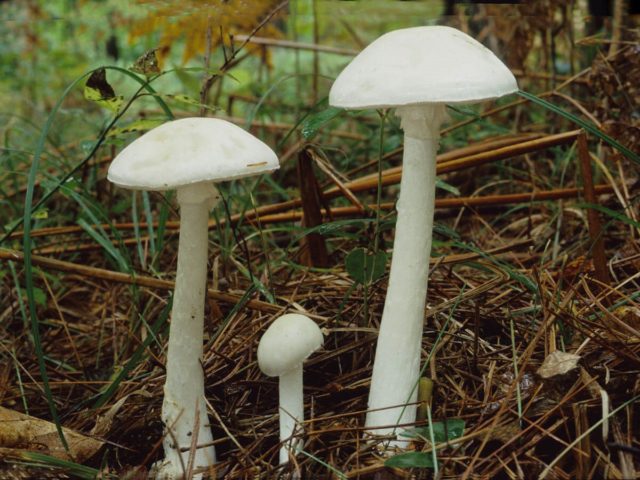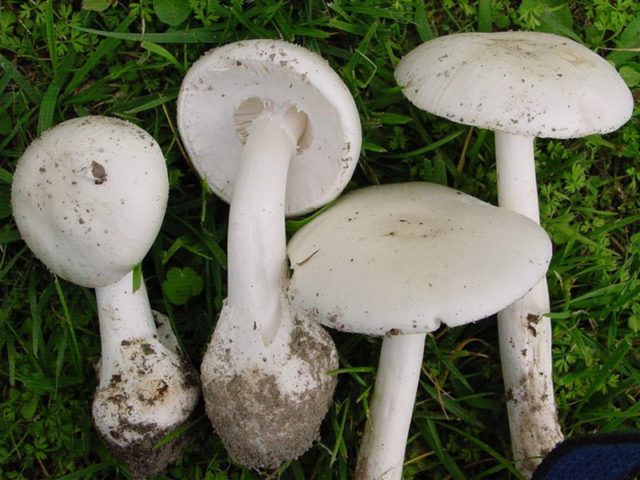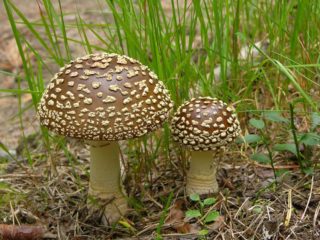Content
The stinking fly agaric (Amanita virosa) is a dangerous mushroom of the Amanita family, order Lamellar. It has several names: foul-smelling, snow-white or white toadstool. Eating it is fraught with severe poisoning and death.
Description of the smelly fly agaric
In order not to grab inedible specimens into the basket, you need to read their description and photo.
Description of the cap
The cap of the stinking fly agaric (pictured) has a wide conical shape and reaches a diameter of 12 cm. The color is white and shiny.When it rains, the surface becomes slightly sticky. The flesh of the cap is white and has an unpleasant aroma.
The plates under the cap are also white. They form freely and often. The spores are spherical, smooth, white in color.
Description of the leg
The leg is smooth, elongated up to 7 cm in length. Its diameter does not exceed 1-1.5 cm. A thickening can be seen at the base. Color – snow-white. A delicate white ring forms on the stem. It quickly disappears, leaving behind a ring-shaped girdle.
Doubles and their differences
The stinking fly agaric has several similar species:
- spring forms a flatter cap. It grows in warm regions and differs from stinking specimens in the season of its appearance. Deadly poisonous;
- ovoid differs in a larger Volvo. Along the edges of the cap, thread-like processes and flakes are visible, by which mushroom pickers identify this particular type of fly agaric. The ring on the stem is small, creamy ocher. This species is listed in the Red Book of the Krasnodar Territory. Considered conditionally edible;
- death cap depending on the growing conditions, it may not have a greenish cap, but a whitish one, which is why it is sometimes confused with the stinking fly agaric. Toadstool is poisonous; mushrooms are equivalent in degree of poisoning;
- float white is an albino variety of the gray floater. The main difference is the absence of a ring, but this is an unreliable sign, since it is destroyed in adult fly agarics. The mushroom is edible, but does not have high nutritional qualities;
- woodland champignon has a whitish-cream cap, so it can be confused with the stinking fly agaric. The difference is that the plates of the champignon darken with age, acquiring an almost black color, while the plates of the stinking fly agaric remain snow-white.Champignon is edible, so you should be extremely careful when picking.
Where and how does it grow
The stinking fly agaric chooses forests with spruce and blueberries. Distributed in the northern part of the temperate climate zone. Grows in coniferous and mixed forests, on wet sandstones.
Is the stinking fly agaric edible or poisonous?
The smelly fly agaric contains muscarine, a toxic alkaloid that affects the human nervous system. Eating fly agarics of this species can result in a tragic outcome.
Symptoms of stinking fly agaric poisoning
The symptoms that occur after eating the stinking fly agaric resemble the signs of poisoning with toadstool. The danger is that the body gives alarm signals too late, approximately 6-24 hours after eating a mushroom dish. During this time, irreversible changes occur: the liver is destroyed and without a transplant of this organ a person cannot survive.
Main symptoms of poisoning:
- unbearable abdominal pain;
- weakness bordering on fainting;
- incessant vomiting;
- diarrhea;
- strong thirst;
- disruption of the heart manifests itself in a decrease in blood pressure to critical values, tachycardia is noted;
- blood glucose levels decrease (hypoglycemia);
- in severe cases, a delirious state occurs.
After 1-2 days, the symptoms subside, but the body does not recover from the illness. This is a period of “false recovery”, after which the patient’s death is possible.
First aid for white toadstool poisoning
In case of poisoning by the stinking fly agaric, you cannot do without medical help.
Algorithm for providing first aid:
- Before the ambulance arrives, the victim is given gastric lavage. To do this, use warm water. The patient is given several glasses of liquid at once, after which vomiting occurs.
- Activated carbon is given to drink at the rate of 1 tablet per 10 kg of weight.
- Regidron is used for dehydration.
- You can drink tea and milk.
- If you have a chill, cover up and apply heating pads to your extremities.
It contains silymarin, which effectively restores liver cells. There are isolated reports in the scientific literature regarding the effectiveness of intravenous use of silymarin in case of fly agaric poisoning. But it is not recommended to use such methods without a doctor’s prescription.
In a hospital setting, acidosis is corrected and water and electrolyte balance is restored. With the rapid destruction of the liver, an organ transplant operation is necessary. Sometimes this is the only chance for salvation.
Conclusion
The stinking fly agaric is a poisonous mushroom that can be easily confused with edible species. Poisoning in most cases is fatal. At the first signs of poisoning, urgent hospitalization is necessary. When picking mushrooms, you should only take known specimens that are not in doubt.
















